A two day Private Tour in Norfolk, we spent Monday in the Brecks before heading up to North Norfolk for an evening looking for owls and Nightjars. On Tuesday, we were out on the North Norfolk coast. The weather was sunny with mostly clear blue skies, and hot, although there was a keen and rather blustery wind on Monday which had died down the following day.
We met down in the Brecks. As it was already approaching mid-morning, we headed straight over to Weeting Heath to look for Stone Curlews before it got too hot. When we got into East Hide, there was no obvious sign of anything on view but a careful scan with the scope revealed a Stone Curlew hunkered down in the grass and flowers, looking rather like a clod of earth, but slightly paler than the clods around it. We had a look at it through the scope, and could see its yellow iris and black-tipped yellow bill as it turned its head.
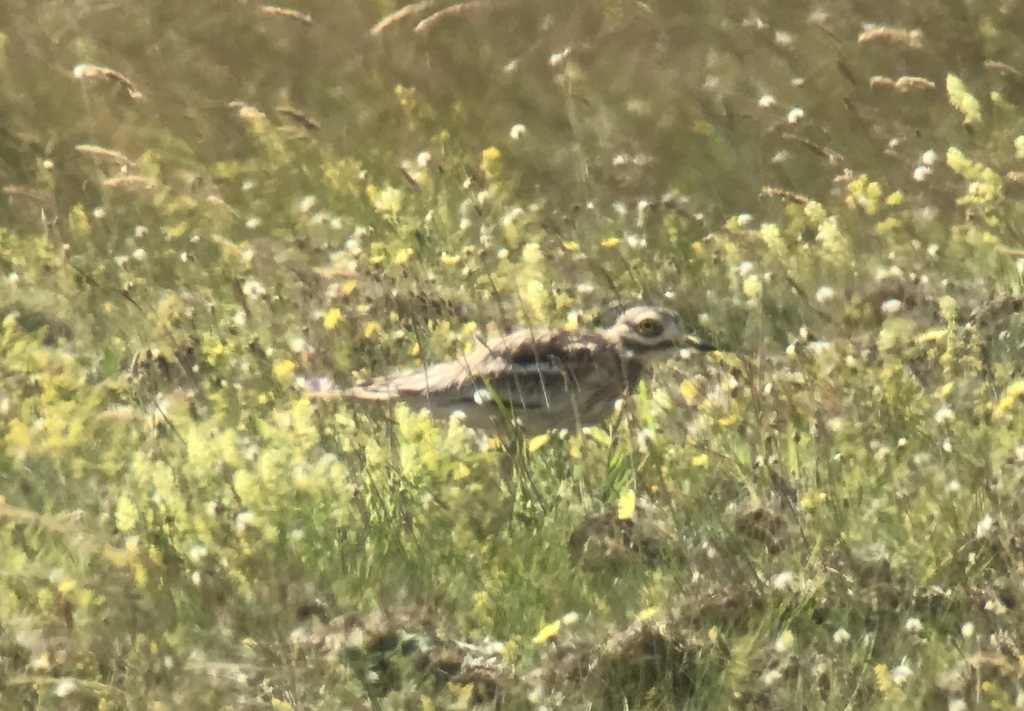
Then another Stone Curlew stood up a little further over to the left. This was a much better view, and we watched it as it walked slowly over towards the first bird. Eventually, it settled down into the grass and disappeared again, so we took that as our cue to move on.
There had been a few tits and a Nuthatch high in the pines on our walk out, but on the way back to the car park we heard a Marsh Tit calling in the bushes ahead of us, its distinctive sneezing call. It flew towards us and landed in an elder right next to the path, just a few feet from us. So close, you didn’t even need binoculars!
From there, we made our way over to Lakenheath Fen. Having checked in at the Visitor Centre, we stopped briefly to look at the feeders. A few tits and Goldfinches were coming and going and a male Reed Bunting made several visits to the feeding table.
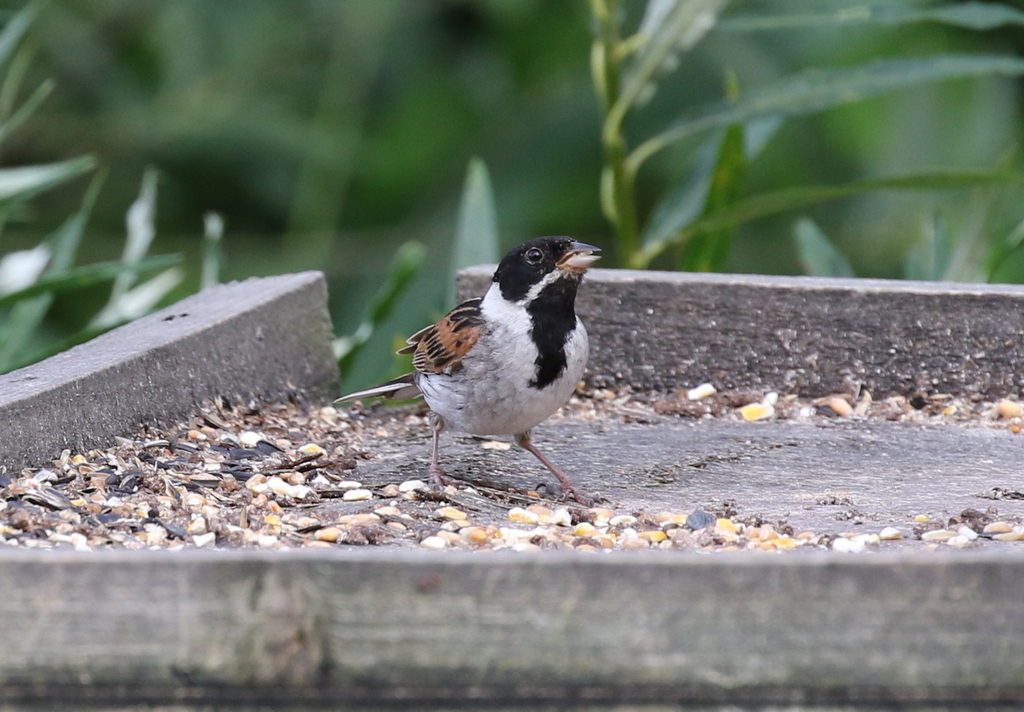
It was a bit too windy out along the main track for butterflies today, but still we saw lots of Red Admirals and a Comma landed on the brambles briefly. A couple of Brown Hawkers were hawking over the reeds and several Ruddy Darters were flying around and perching in the grass by the path. Most of the damselflies were hiding in the vegetation, but we did see one or two Azure Damselflies.
We stopped at the New Fen Viewpoint and looked out over the pool below. A Great Crested Grebe was still on its nest on the edge of the reeds, and what was presumably its partner appeared and swam out into the middle of the water. There were a couple of well-grown broods of Gadwall and some moulting Mallard at the back, along with several Coot and Moorhen. A Reed Warbler was feeding low down along the edge of the reeds at the back.
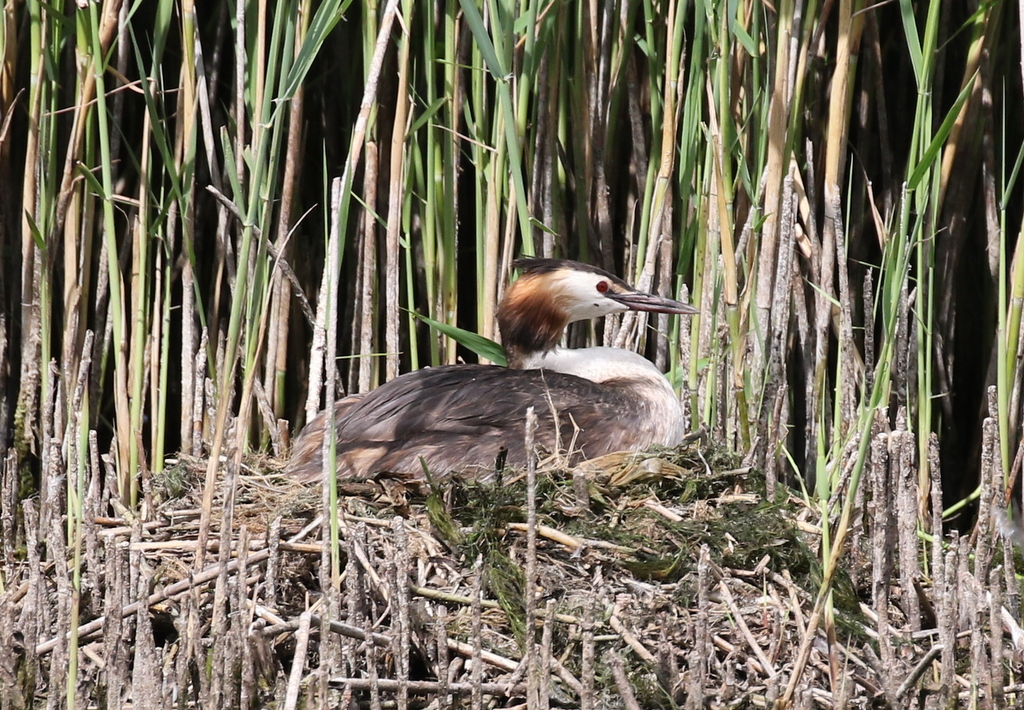
Continuing on along the track towards Mere Hide, there were one or two Black-tailed Skimmers basking on the gravel which kept flying on ahead of us. We had a junior member of the group with us who could hear loud buzzing in the grass by the track, whereas the grown-ups couldn’t hear it above the wind. It was a Roesel’s Bush-cricket and following the noise, we eventually found several in the vegetation and watched one stridulating.
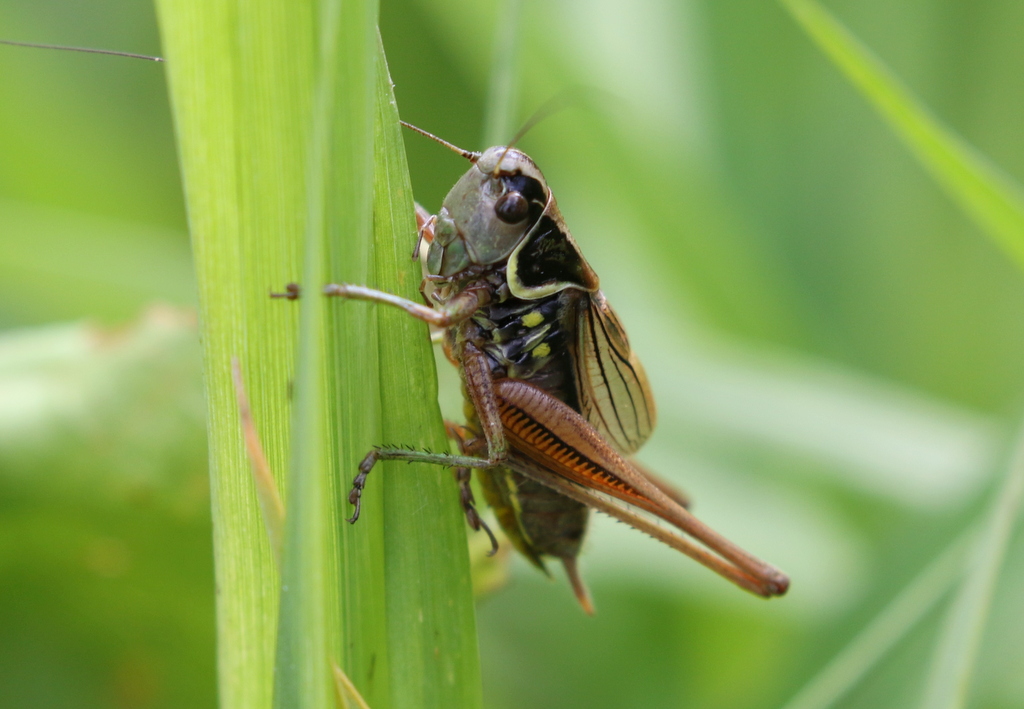
From the hide, we could see a family of Little Grebes away to the left at the back of the open channel, an adult feeding two well-grown juveniles. A flock of five Little Egrets flew over towards, heading over towards Joist Fen. Several Four-spotted Chasers were flying around the edges of the water or perching on reed stems. Otherwise it was rather quiet here today, we we decided to continue on to Joist Fen.
As we sat on the benches looking out over Joist Fen, it was rather quiet here too at first. A few Marsh Harriers circled up from the reeds from time to time, a male with the silvery-grey panel it is upperwings, a female and one or two dark chocolate brown juveniles. A couple of Common Terns commuted back and forth from the pools out in the middle of the reeds.
One or two Reed Warblers flicked in and out on the edge of the reeds. We heard Bearded Tits calling several times, but they were mostly hidden behind the reeds down at the front of the pool, just below the viewpoint, until a juvenile flew back across the water and landed in the reeds at the back.
Then two Common Cranes appeared, flying across low over the reeds, before dropping down away from us into the reeds out in the middle out of sight. As well as the breeding pair which still has a youngster which has not yet fledged, there have been two different Cranes seen from time to time around the reserve recently. They were presumably the ones we saw, possibly returning juveniles from 2018 according to reserve staff. Several Little Egrets had already flown in and out and when a Great White Egret appeared. It came up out of the reeds, much larger, with slower wingbeats, and flew back away from us.
We had been hoping to see a Bittern here, and normally this is a good time to see them as they fly back and forth regularly with food for their young, but they have not been very active this summer. The reserve staff hope that there are still good numbers breeding, after a record count of eleven booming males in spring here, and think they may just be walking to find food due to the conditions.
It was nice sitting here in the sunshine with the breeze over the reeds, so we decided to wait some more. A Grey Heron came up and did a fly round. When it dropped down out of sight in the reeds again, it chased a second Grey Heron out. Finally, a Bittern put in an appearance, flying up out of the reeds over towards the river bank, across low over the tops, before dropping back in out in the middle. Success!
It was a long walk back to the Visitor Centre and was early afternoon already by the time we got back. We stopped for a cold drink and a snack to recover. With evening activities planned too, we didn’t have much time this afternoon, but we called in quickly at Lynford Arboretum. There was lots of activity around a tree laden with berries in the car park – several Blackbirds coming and going, and a family of Garden Warblers. We watched the adult feeding one of the juveniles up in the top.
As we walked down the path towards the bridge, a Siskin flew over calling. There were not many birds out in the heat of the afternoon, so we carried on down to the lake. Several Little Grebes out among the lilypads, including an adult feeding two juveniles. An Emperor Dragonfly was hawking over the water. Making our way back up towards the car park, we stopped to look at the feeders by the cottages and a Great Spotted Woodpecker flew out.
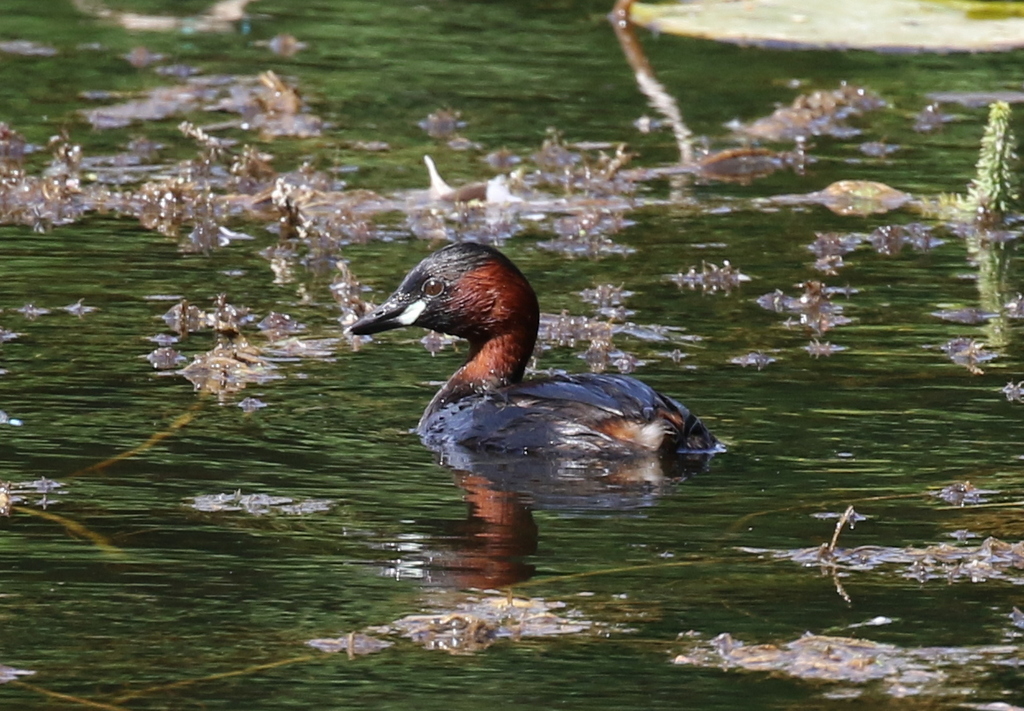
On our way north, we stopped off again in the forest. We parked by a clearing and walked a short way out along a ride through the middle. A Yellowhammer was singing from the top of the pines on one side, and we found an Essex Skimmer in the grass (we could see the black tips to the underside of its antennae) but there was not much else here today so we carried on our way.
After a break to get checked in and get something to eat, we met again in the evening. First, we drove over to a site to look for Little Owls. As soon as we pulled up, we could see one of the adults perched on the roof of some old farm buildings. We watched from the minibus as it stood there staring at us, a great view.
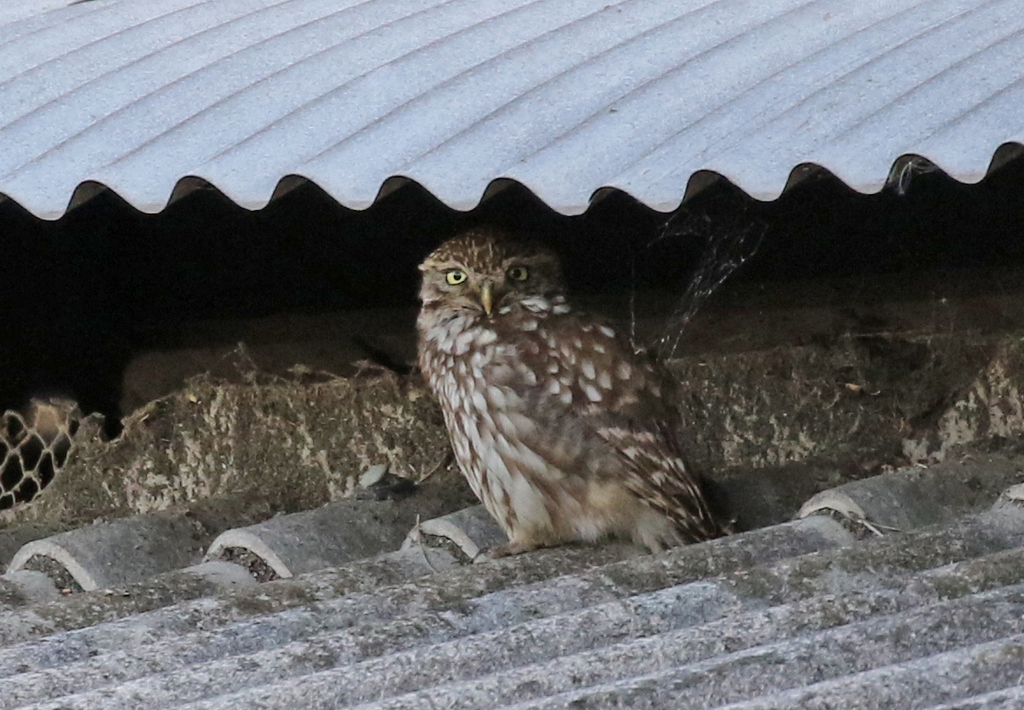
As the adult Little Owl seemed fairly settled, we pulled a little further forwards and could see two paler grey, fluffier juvenile Little Owls on the same roof a little further down. They were more active, looking round, stretching their wings, running up under cover and back down into the open. We stayed and watched them for a short while, then headed down to the coast to look for Barn Owls.
We drove round through an area of meadows where the Barn Owls like to hunt, but there was no sign of any out yet. So we parked and walked down along the bank by the grazing marshes. Several Common Swifts were screaming around the rooftops of the village nearby – it won’t be long now before they are off, on their way south. A few House Martins circled in with them. A Grey Partridge was feeding in the grass on the edge of a ditch across the meadows.
Scanning from the bank, we picked up a very distant Barn Owl out over the back of the marshes, hunting. As we watched it, it seemed to be coming a bit closer, flying towards us, but then it turned and went back out into the middle. At least we had seen a Barn Owl. We turned to walk back to the minibus and another Barn Owl appeared from behind the reeds back towards the road. It was the regular all-white male, a stunning bird! It flew straight past us and disappeared round over the bank.
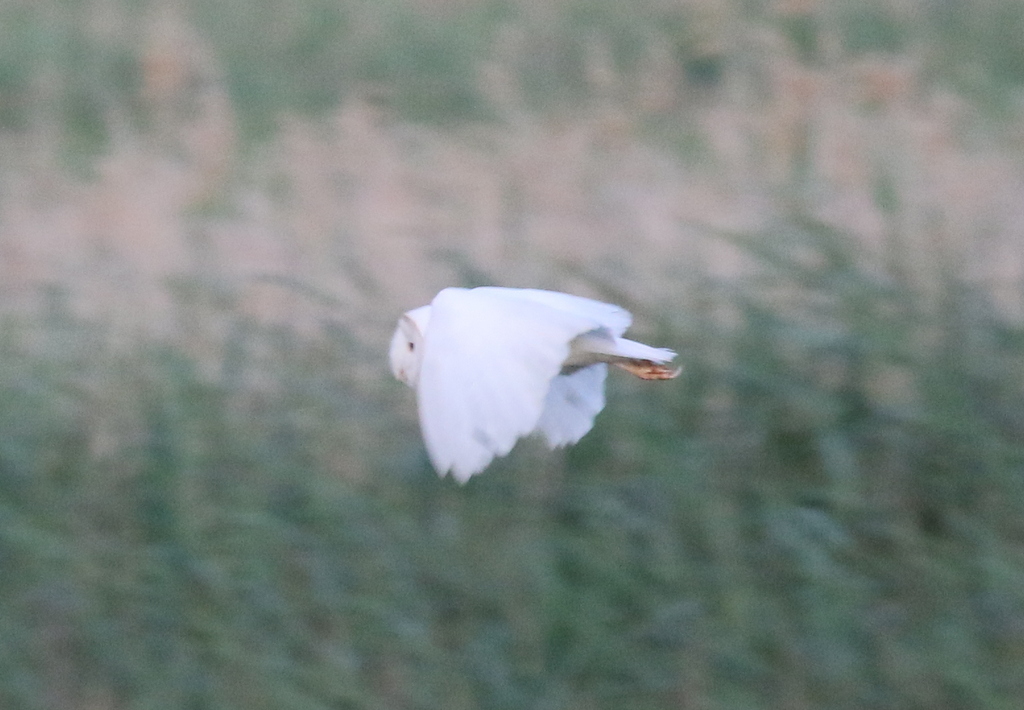
It was time to get up to the heath for this evening’s main event now. As we walked out into the middle of the heath, we spotted a large bat flying over the tops of the pines, probably a Noctule.
We didn’t have long to wait before we heard the first Nightjar of the evening calling. It sounded like it was flying round in the trees at first, but then it came out over the edge of the heath, circling round a few times in front of the trees. Then it turned and came right past us, heading out into the middle. A male, we could see its white wing patches as it came past. It dropped down out of view and started churring.
Another Nightjar called from trees. It too flew round like the other had done earlier. It landed briefly on a branch, one of its favourite churring posts, and we got it in scope, but it didn’t stay long. It flew round past us and out into the middle of the heath too,another male. We stood and listened to the churring and from time to time could see one flying round, hawking for insects.
Then one of the male Nightjars flew back in low over the heath and came back right past us, another good view. It flew up into an oak tree quite close to where we were standing and started churring. Great to hear up close. Unfortunately it was obscured by leaves where we were standing and as we tried to walk round to the other side to see if we could see it, it dropped out of the tree and flew back out into middle again.
After a long day, it was time to call it a night. We could hear another Nightjar churring as we walked back to the minibus, and a Tawny Owl hooting away in the distance. It was time for bed.
After our late night last night, we had a more relaxed start to the morning today. After we met up, we headed down to Wells. As we parked, we could already see the Spoonbills. There were at least six, tucked in the grass, asleep. There were several Little Egrets with them too and hard to tell what some of the white shapes were from here, further over hidden by the vegetation.
After a while, two of the Spoonbills woke up. One was one of this year’s juveniles, from the breeding colony at Holkham. When they want to be fed they are relentless, and we watched the juvenile as it walked over towards the adult and started begging, bobbing its head up and down and flapping its wings. The adult tried walking away, but the juvenile followed. After a while, the adult tried flying away but the juvenile just flew after it and carried on begging when it landed. In the end, the adult gave in.
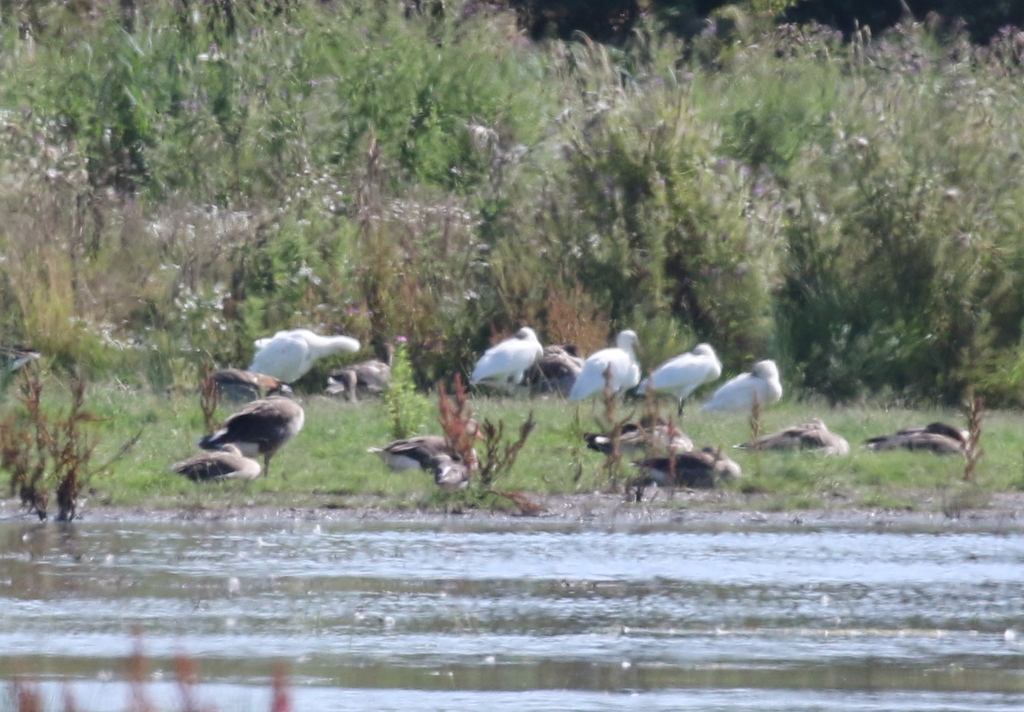
There were a few waders on the pools here too. We could see a distant Greenshank roosting on the back of one pool, but then found another feeding close to the track on the other side. A Green Sandpiper appeared from behind one of the islands too. A large flock of Black-tailed Godwits was out in the middle and there were still plenty of Lapwings, presumably the local breeding birds. There is just one pair of Avocets left here now though. Most have finished breeding and moved off elsewhere to moult, but these ones still have a cute, half-grown fluffy juvenile. Moulting will have to wait until family duties have finished!
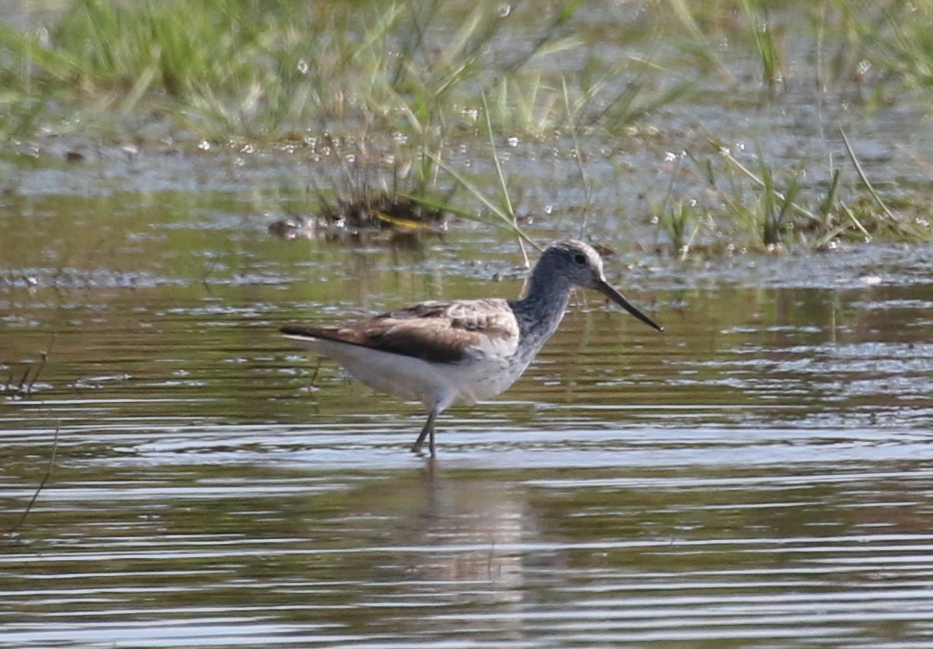
We watched a lovely grey male Marsh Harrier circling over the fields beyond the pools. Then a female appeared and flew in over the pools and past us.
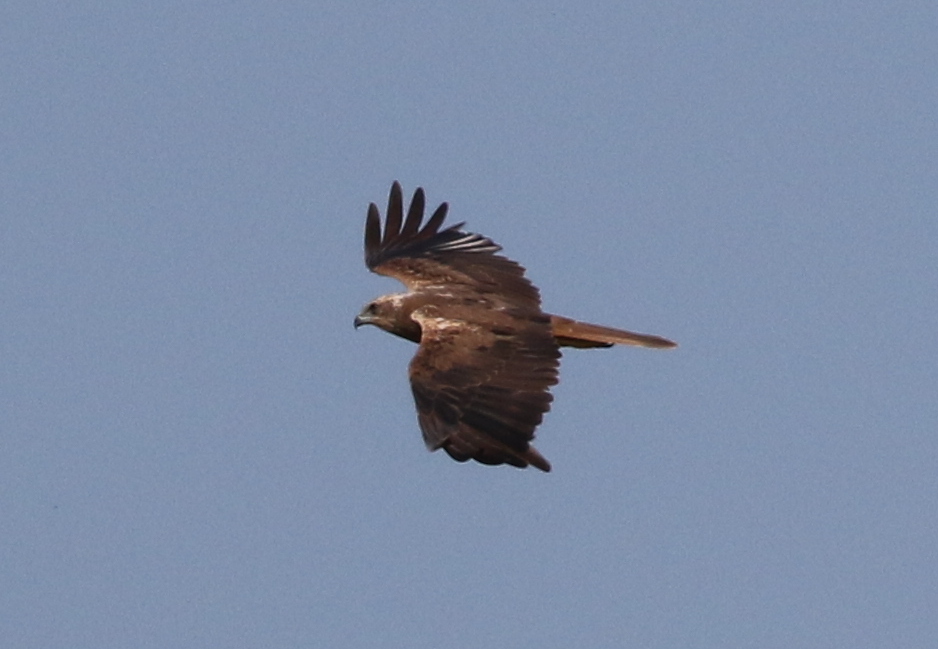
There were several Reed Buntings along the track, and Linnets and Goldfinches in the bushes, along with a few House Sparrows. When we heard a Sedge Warbler calling, we turned and could see it climbing around in the base of a large hawthorn by the edge of the ditch behind us.
We moved on from here, driving west along the coast road all the way to Holme. It was hot already, but there was a nice breeze coming in off the sea as we walked out through the dunes. A big dragonfly flew past – an emperor, but with a dark abdomen with a bright blue segment at the base. A Lesser Emperor! It disappeared straight off east through the dunes, presumably fresh in. There were hirundines on the move too today, little groups of Swallows and Sand Martins heading along the coast.
As we walked out towards the beach, we could hear Sandwich Terns calling, from the shore we could see a steady stream flying past. They were heading back to the breeding colony at Scolt, most carrying fish for their young which they had presumably caught in the Wash. Some of them came past us very close, so we could clearly see the yellow tip to their black bills (despite them being full of fish!). A couple of orange-red billed Common Terns came past too.
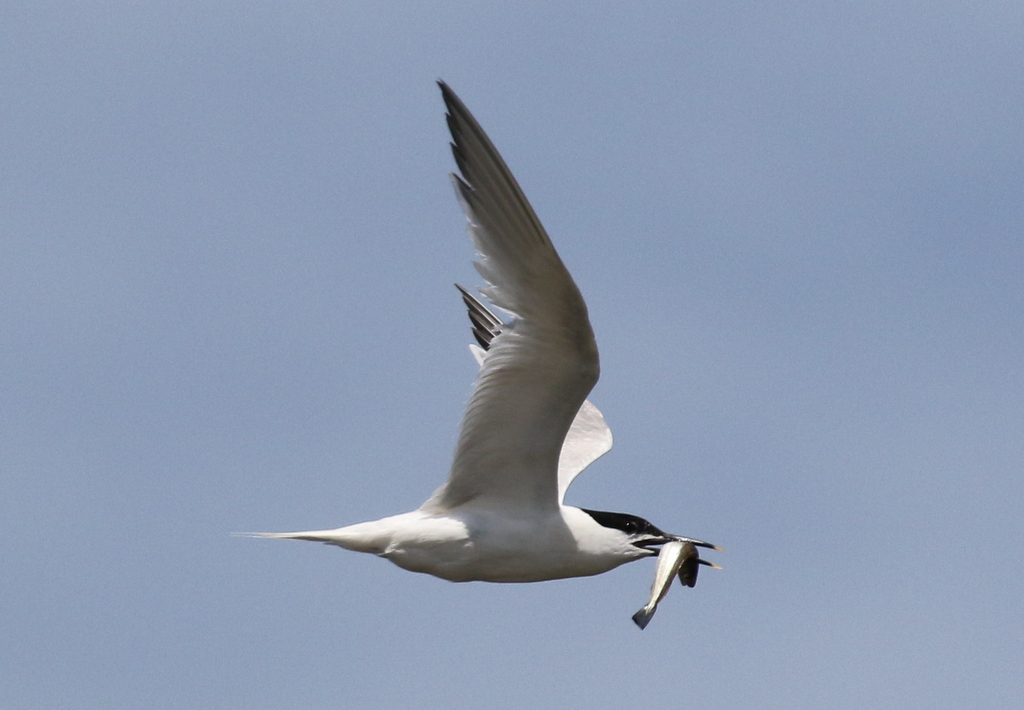
There were a couple of Little Terns diving just off the beach at the point away to our west, so we walked along to try to get a closer view. There were two at first, then four. They drifted off west, and when they came back again there were at least ten. We had great views of them fishing just offshore. As well as the small size, we could see their black-tipped yellow bills and white foreheads.

There was a single Bar-tailed Godwit on the point and several Ringed Plovers higher up on the beach. A flock of waders flew in and landed on the point. We got them in the scope and could see they were mostly Sanderling, at least 150 of them, with the majority still largely in dark breeding plumage. Very different from the silvery grey and white ones we see in the winter. There were around ten Dunlin in with them, the black bellies of their breeding plumage immediately identifying them.
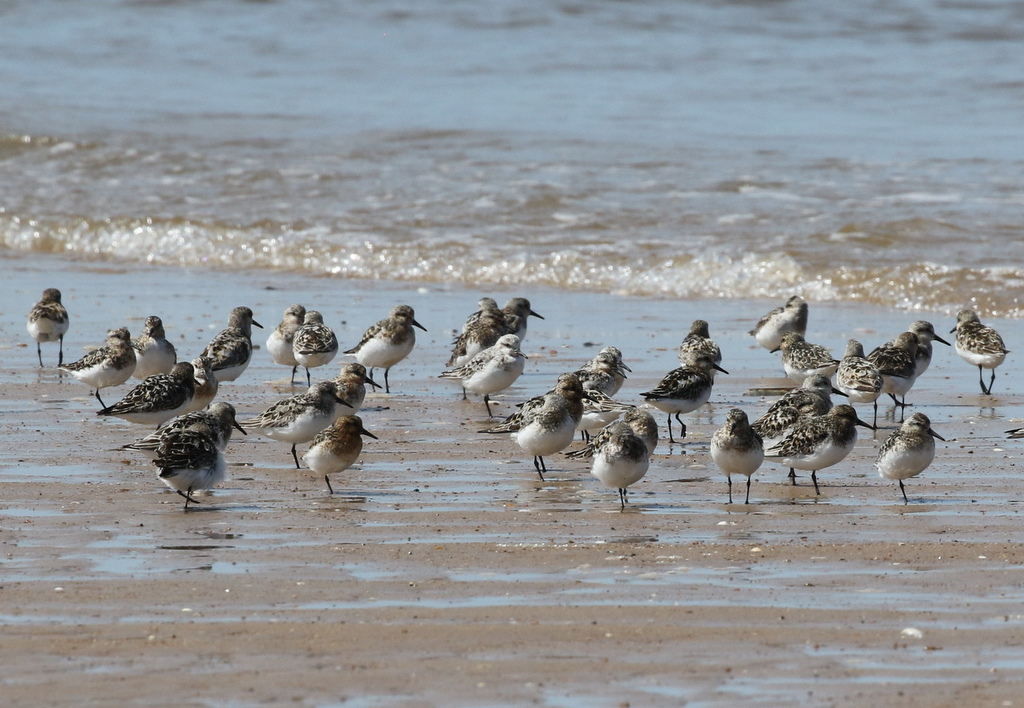
Looking away to the west, towards the mouth of the Wash, we watched as a huge flock of birds flew up. They were largely Knot, probably at least 2,500 of them. It was amazing to watch as they whirled round out over the sea, presumably having been spooked from where they were roosting over high tide. Some flew over our way and past over the sea, and we could see they were also mostly still in their rusty breeding plumage.

It was very pleasant out on the beach today, particularly with so much to see, and our junior correspondent even went for a paddle. Eventually, it was time to walk back and get some lunch. We drove round to the village to the White Horse for a cold drink and a sandwich. Then it was on to Titchwell for the rest of the afternoon.
Making out way out onto the reserve, we stopped first at the reedbed pool where a Great White Egret was lurking in the reeds on one side. Through the scope, we could see its long snake-like neck and dagger-shaped yellow bill. There were several ducks on here, Common Pochard and Tufted Duck being new for the trip list, and two Great Crested Grebes, one adult and a juvenile.
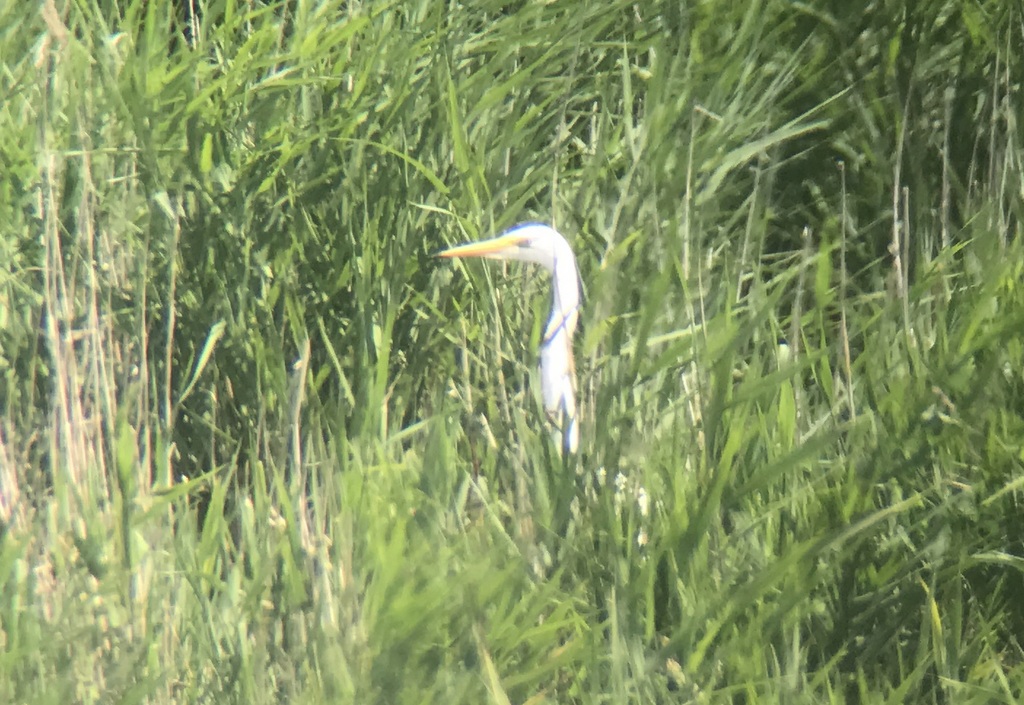
We particularly wanted to see the Semipalmated Sandpiper which had been here for a few days now, so we decided to head straight out towards the Tidal Pools which was where it had been seen todat.
On the way, we spotted at least six Spoonbills on the island at the back of the Freshmarsh. A smart Black-tailed Godwit was feeding at the front on the mud, and as we walked along the bank more flew up and headed out west, flashing their distinctive black and white wings. Several Ruff were also feeding on the mud below the bank, bewildering in their variation with no two looking the same and all looking patchy, at different stages of moult.
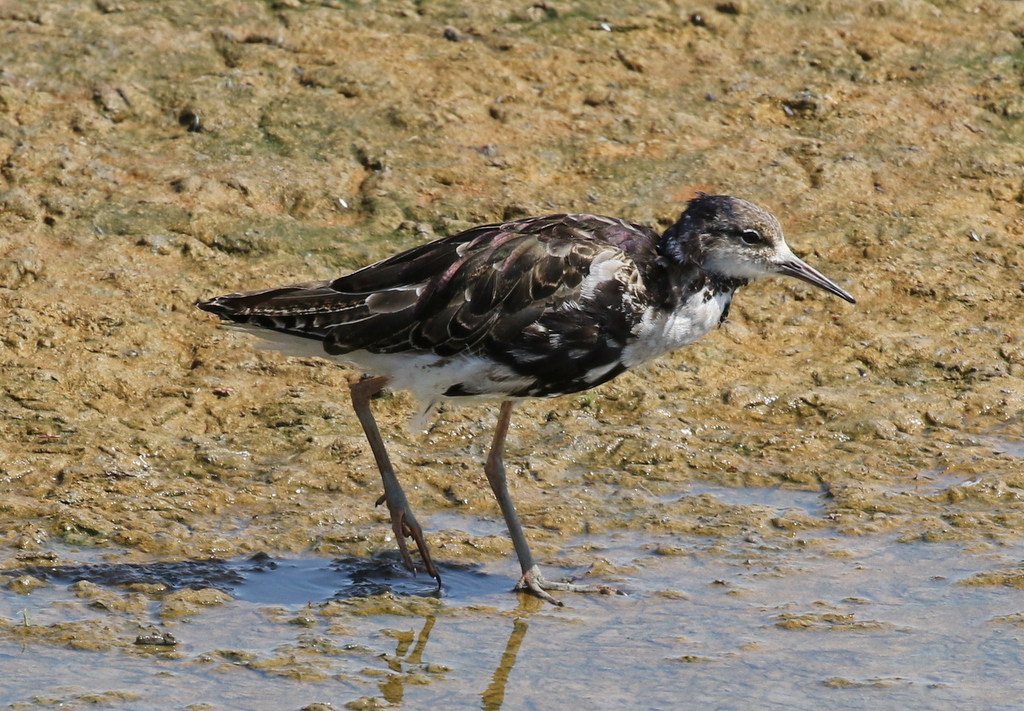
We stopped briefly to look at an adult Mediterranean Gull roosting in with the Black-headed Gulls on one the islands, one of the other birds we had hoped to catch up with here today. We could see its brighter, heavier red bill, blacker hood, and white wing tips, compared to the neighbouring Black-headed Gulls.
Pressing on to the Tidal Pools, when we got there the Semipalmated Sandpiper had just been chased off by Turnstones and walked into the vegetation out of view. We had a look at the Turnstones, still mostly in their bright breeding plumage. There was also a small group of Dunlin, feeding on the edge of the island, plus Redshanks and Oystercatchers roosting.
The Semipalmated Sandpiper did walk out for a couple of seconds but went back in before we could all get a look at it. At least it was still there. We didn’t have too long this afternoon though, so we decided to walk back to Parrinder Hide and come back again later. A friend who was still waiting promised to let us know if it reappeared.
The Great White Egret was now on the Freshmarsh, preening out on one of the islands amongst all the gulls, looking oddly out of place. A single orange Knot in breeding plumage was feeding nearby, so we could get this one in the scope and have a better look at it than the ones which had flown past earlier.
From the hide, we could really appreciate just how many Avocets there are on the Freshmarsh now, with over 600 counted in the last day or so. They gather here to moult at this time of the year, so some of these birds may have come from very different places. They were mostly sleeping on the islands. We also had a nice close view of a Black-tailed Godwit still in breeding plumage in front of the hide, where we could clearly see the rusty colour of the head extending down to the breast and then barred with black on a white belly.

Several juvenile Pied Wagtails were flitting around in front of the hide and out on the short grassy islands. A juvenile Yellow Wagtail was in with them, browner above and creamy yellow below. Some of the Spoonbills were awake now, and we watched a couple of juveniles practicing feeding, sweeping their bills from side to side in the shallow water. We could see there were more Mediterranean Gulls here, in with Black-headed Gulls. A good opportunity to practice newly-learnt Mediterranean Gull identification and pick them out!
The phone buzzed, as a message arrived to say that the Semipalmated Sandpiper had come out, so we walked quickly back to the Tidal Pools. By the time we got there, it had of course disappeared back into the vegetation again but after scanning for a minute or so, we found it standing in a patch of short samphire. It was rather tucked in at first, but then put its head up, looking round. Then suddenly all the waders took off and headed straight out towards the beach. The Semipalmated Sandpiper appeared to go down with them.
We walked up onto the dunes and scanned the beach from the top. The tide was just going out and the mussel beds were only starting to be exposed in a few places. Thankfully it meant there weren’t too may places to hide and we quickly relocated the Semipalmated Sandpiper with a Dunlin feeding down on the shore. It was distant from here, so we walked down for a closer view, and had a really good view of it from the beach.

Semipalmated Sandpiper is a rare visitor here from North America, closely related to our Little Stint. It is more often seen on the west coast, and particularly unusual here in Norfolk. It gets its name from the small amount of webbing between the base of its toes, which is not shown by our stints.
It was a nice way to end our two days. After seeing a good variety of our breeding bids, as well as a selection of returning passage waders, we got to round it off with a proper rarity. Unfortunately we had to get back as there was a train to catch. It had been a very enjoyable couple of summer days out.
















